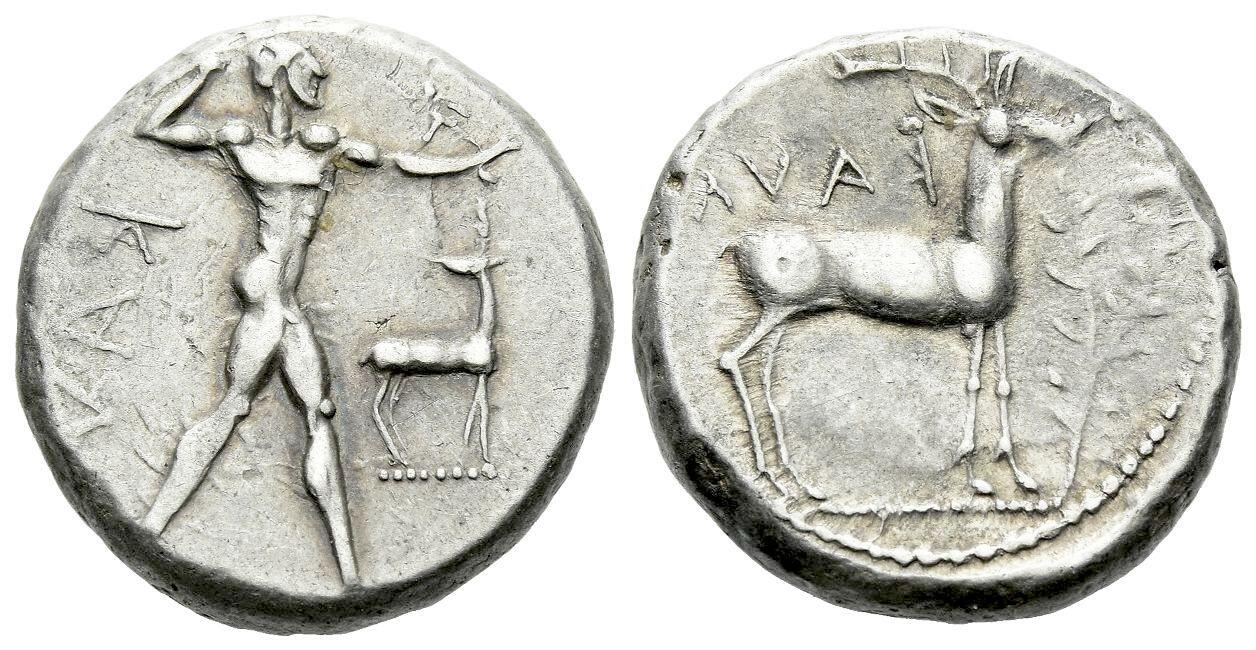480 BCE - 460 BCEΛAS | ΛAS
Overstriking coin
SO 1208 - Laüs over Caulonia.jpg
[1]
|
|
Sale(s)Sale(s) ᵖ:
|
Numismatica Ars Classica, 29, 11 May 2005, 32
|
|
|
|
Description
| ObverseInscription or printing placed on the obverse.:
|
ΛAS (Greek) Man-headed bull left, head reverted. In exergue, acorn.
|
ReverseInscription or printing placed on the reverse.:
|
ΛAS (Greek) Man headed bull (Acheloo) right.
|
Mint and issuing power
| MintIdentifies the place of manufacture or issue of a numismatic object.:
|
Laüs
|
Ancient regionAncient region.
|
Lucania
|
Modern countryModern country: Italy
|
AuthorityIdentifies the issuing power. The authority can be "pretended" when the name or the portrait of X is on the coin but he/she was not the issuing power. It can also be "uncertain" when there is no mention of X on the coin but he/she was the issuing power according to the historical sources:
|
|
Chronology
| FromIdentifies the initial date in a range assigned in a numismatic context. 480 BCE toIdentifies the final date in a range assigned in a numismatic context.. 460 BCE
|
Classical 480-323 BC  periodTime period of the numismatic object. periodTime period of the numismatic object.
|
Physical description
MetalThe physical material (usually metal) from which an object is made.: Silver 
|
WeightWeight of the numismatic object (in grams). in grams: 7.977.97 g <br />7,970 mg <br />
|
DenominationTerm indicating the value of a numismatic object. Examples: tetradrachm, chalkous, denarius.: nomos
|
|
|
|
StandardStandard.: Achaian
|
References
Description
| ObverseInscription or printing placed on the obverse.:
|
Naked Apollo standing right, holding branch in raised r. hand: on extended l. arm small running figure. In field r., stag with head turned back
|
ReverseInscription or printing placed on the reverse.:
|
KAVΛ retrograde (Greek) Stag standing right
|
Mint and issuing power
| MintIdentifies the place of manufacture or issue of a numismatic object. ᵖ:
|
Caulonia
|
Ancient regionAncient region. ᵖ
|
Bruttium
|
Modern countryModern country: Italy
|
AuthorityIdentifies the authority in whose name (explicitly or implicitly) a numismatic object was issued. ᵖ:
|
|
Chronology
| FromIdentifies the initial date in a range assigned in a numismatic context. 475 BCE toIdentifies the final date in a range assigned in a numismatic context.. 425 BCE
|
Classical 480-323 BC  periodTime period of the numismatic object. periodTime period of the numismatic object.
|
Physical description
| DenominationTerm indicating the value of a numismatic object. Examples: tetradrachm, chalkous, denarius. ᵖ:
|
nomos
|
|
|
References
References
- ^ Clarke, Louis C. G. (1940), Sylloge Nummorum Graecorum. Great Britain. Vol. 4 : Fitzwilliam Museum : Leake and general collections. Part 1, Spain (Emporiae, Rhoda)-Italy, London, Oxford University Press.
- ^ Sylloge Nummorum Graecorum, Great Britain Vol. 2 : The Lloyd Collection. Part 1-2 Etruria to Thurium, Part 3-4 Velia to Eryx, Part 5-6 Galaria to Selinus, Part 7-8 Syracuse to Lipara
- ^ Rutter N. Keith et alii (eds.) (2001), Historia Numorum Italy, London, xvi, 223 p., 43 pl.
- ^ Hoover, Oliver D. (2018), The Handbook of Greek Coinage Series, Volume 1. Handbook of Coins of Italy and Magna Graecia, Sixth to First Centuries BC., Lancaster-London, 2018, lxi, 527 pages, 23 cm
- ^ Noe, Sydney P. (1958), The coinage of Caulonia, Numismatic Studies 9, New York, 62 p., 20 pl.

